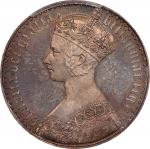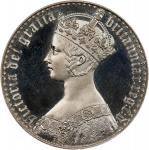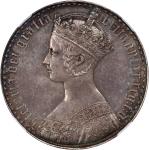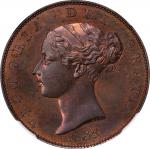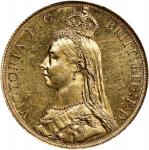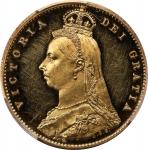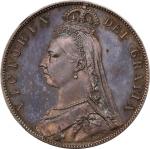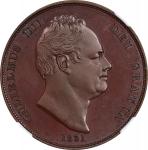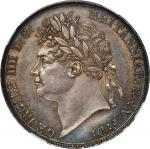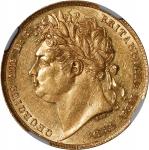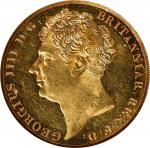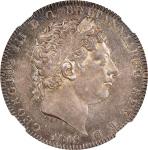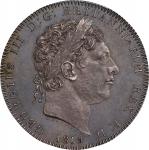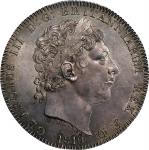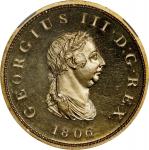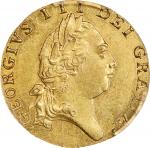GREAT BRITAIN. Gold "Una and the Lion" 5 Pounds Pattern, 1839. London Mint. Victoria. PCGS PROOF-63 Deep Cameo. S-3851; Fr-386; KM-742; WR-278 (R4). By William Wyon. Wilson and Rasmussen lists a total of eight die varieties for this type, with the present example identified by its "DIRIGE…" reverse legend, small lettered edge, and six full scrolls on the obverse headband. Masterfully produced in medallic high relief, this hefty gold five sovereign issue is often found with fully intact frost over the devices, rendering the portrait and the figures of Victoria and the Lion in stark, striking detail that only accentuates the beauty of Wyons artistry. The present example is no exception, the matte-like texture of the raised portions of the design offering an eye-catching contrast to the watery and deeply mirrored yellow-golden fields beneath. Mild hairlines are present but well-hidden in the fields, in line with the assigned grade.
William Wyon (1795-1851) led a long and illustrious career as an engraver of British medals and coinage, hailing from a family of diesinkers in Birmingham and serving as Chief Engraver of the Royal Mint from 1828 until his death in 1851. He was a prolific and highly regarded artist in his lifetime, the creator of such famed pieces as the 1817 "Three Graces" and "Incorrupta" pattern Crowns, the 1847 "Gothic" Crown, and the 1831 coronation medal for William IV, among many others. His work can primarily be classified under Neoclassicism, a popular art movement of the 18th and 19th centuries that drew heavily upon works of the Renaissance and classical antiquity, featuring themes of grandeur in conjunction with a simplicity of style.
Wyons most renowned work may be his 1839 "Una and the Lion" 5 Pounds issue, produced for the delayed coronation of Queen Victoria, who ascended to the throne in 1837. The design, in characteristic Neoclassical fashion, draws direct inspiration from Edmund Spensers Renaissance-era epic poem, "The Faerie Queen." Book I of the epic follows the adventures of the noble Redcrosse Knight and his lady, Una. In one scene, Una is charged upon by a wild lion after becoming separated from her companion, but in the face of Unas beauty and purity, the lion is instantly tamed, and thereafter accompanies her as a faithful protector.
In a time of great social mobility, with the Industrial Revolution in full force, coupled with a gradual movement away from a traditional rigid social hierarchy in the wake of two centuries of mercantilist policies (which led to a significant redistribution of wealth from the nobility to the middle class), and following the largely unpopular and at best ineffectual reigns of George IV and William IV, the structure of the British monarchy as a whole had increasingly become regarded as archaic. Indeed, the accession of Victoria on 20 June 1837, less than a month after her 18th birthday, would mark the beginning of the transition of the monarchy to a primarily ceremonial role.
Victorias coronation took place on 28 June 1838, a little over a year after her accession to the throne, presumably having been delayed in an effort to train and prepare her for her new role, as she had not been raised with the expectation of queenhood. Wyons coronation set would be issued a year later. His usage of the Una and the Lion imagery for his representation of Victoria upon the largest denomination within the set was clever in its execution but controversial by nature; it was the first time in history that a British monarch had been depicted on a coin as a fictional character. Nevertheless, it served its function as propaganda, highlighting and romanticizing the Queens youth and purity while simultaneously portraying her as a noble and capable leader, in an effort to sell her to the public.
Wyons Una is rendered as the upright figure of a young Queen Victoria, royal orb and scepter in hand, clothed in an elaborate medieval gown. At her side, the enormous strolling lion functions both as the character from Spensers epic and as a symbol of Great Britain, a mighty force diligently following its queen. Above the figures are the words "DIRIGE DEUS GRESSUS MEOS" ("May God Direct My Steps"), a holy entreaty and a message of hope in the wake of the accession of a vibrant young leader. This large and impressive gold Pattern issue found immediate popularity, and the original mintage of approximately 400 pieces was soon found to be wanting. The beauty and grace of Wyons imagery and the mystical romanticization of the young queen appealed to many, and the Royal Mint assuaged the heavy demand by striking additional examples upon request for nearly fifty years, reportedly until 1886, an endeavor that resulted in the production of several additional dies. Of the eight known die pairings, the most common is W&R-279 (R2), which is most often associated with the original proof set. The present W&R-278 (R4) is a close second, with the other varieties generally being scarce to rare. <strong>To view all items from the Louis E. Eliasberg, Sr. Collection, click <a href="https://auctions.stacksbowers.com/lots?sort=auction_date_lot_number_asc&search=Louis+E.+Eliasberg%2C+Sr.+Collection.&limit=96&lots_range=upcoming"> here.</a></strong> From the Louis E. Eliasberg, Sr. Collection.



